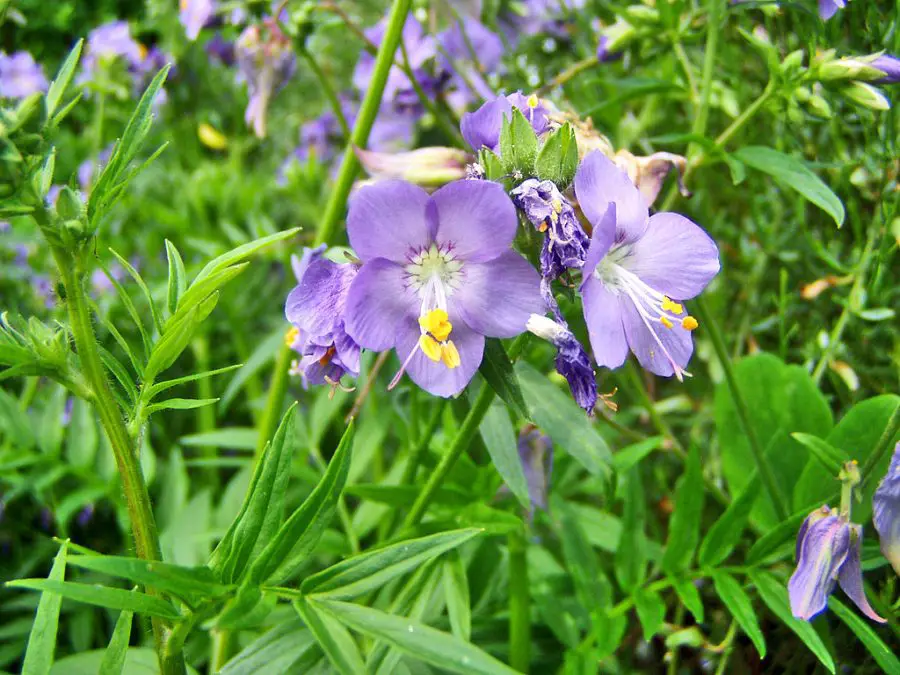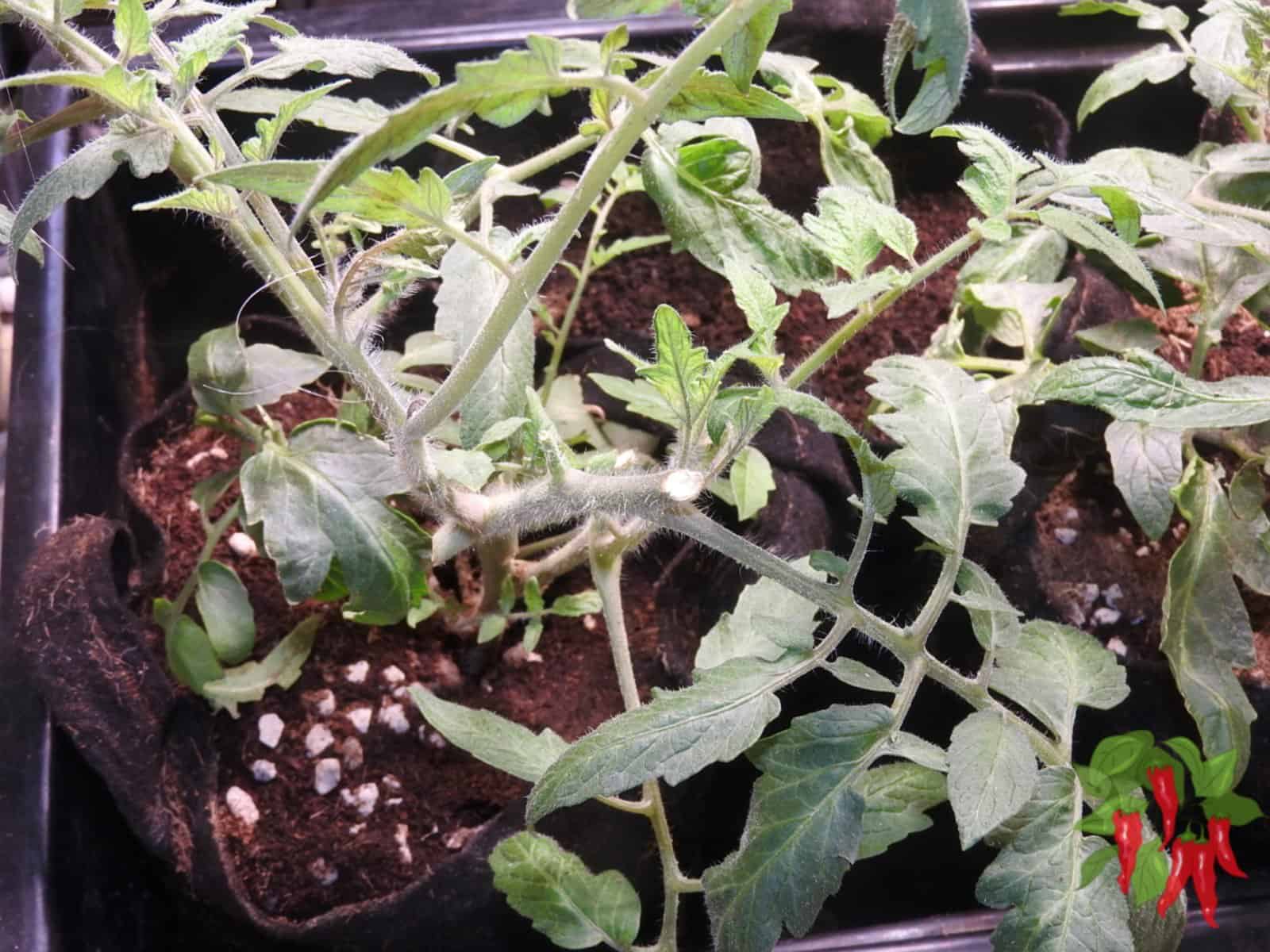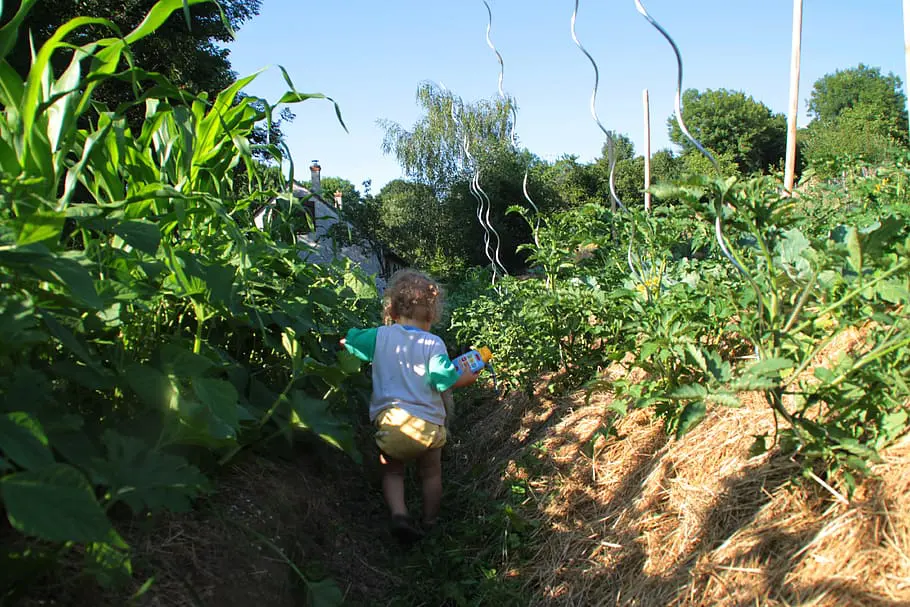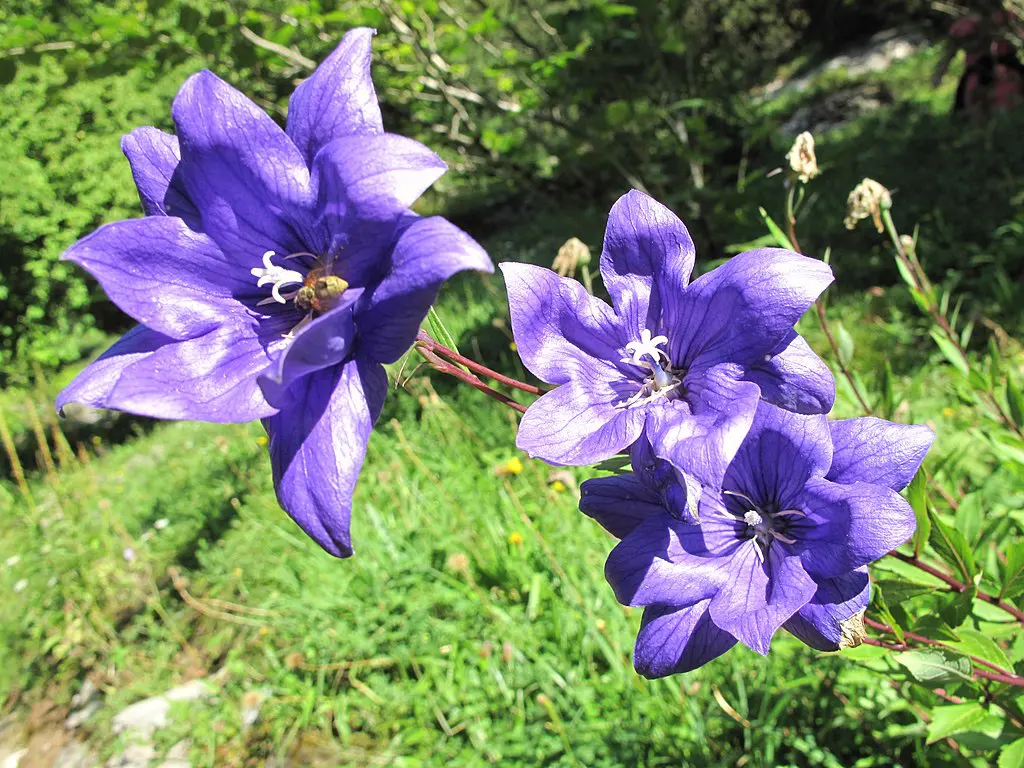This post contains affiliate links. If you buy something from one of our links we may earn a commission. Thanks

Looking to add a touch of nature to your indoor space? Discover the ins and outs of growing Jacob’s Ladder indoors. From planting to care, we’ve got you covered!
Growing Jacob’s Ladder indoors is possible with the right conditions. Choose a well-draining pot and fill it with rich, loamy soil. Place the pot in an area with indirect light, as direct sunlight can scorch the leaves. Maintain consistent moisture and a cooler indoor temperature for optimal growth.
So you’ve heard about the allure of Jacob’s Ladder and you’re thinking, Why not bring that botanical beauty right into my own home?
You’re in the right place! Growing Jacob’s Ladder indoors isn’t just a green thumb’s dream; it’s a rewarding experience that can transform your living space into a cozy, natural haven.
Stick around, and we’ll guide you through every step of the way.
Growing Jacob’s Ladder Indoors (Polemonium caeruleum)
Growing Jacob’s Ladder indoors is a rewarding experience for any plant lover. This perennial plant thrives in well-drained soil and partial shade, making it ideal for indoor conditions. With proper care, including regular watering and occasional deadheading, you can enjoy its vibrant, bell-shaped flowers and unique leaf arrangement year-round.
You’ve stumbled upon the captivating world of Jacob’s Ladder, or as the botanists like to call it, Polemonium caeruleum.
And now, you’re wondering how to make this plant buddy a permanent guest in your home. Great news!
Growing Jacob’s Ladder indoors is simpler than you might think. In this post, we’ll dive into everything from the ideal soil and lighting conditions to seasonal care and even how to handle those pesky pests.
So grab a cup of tea, and let’s turn that thumb of yours a shade greener!
Brief Overview of Jacob’s Ladder
Ah, Jacob’s Ladder, a name that instantly conjures images of stairways to heaven or maybe even a classic movie.
But we’re talking about the plant here, not the biblical tale or a film.
Scientifically known as Polemonium caeruleum, this perennial plant is a real showstopper with its unique leaf arrangement and bell-shaped flowers.
Native to the temperate zones of Europe and Asia, it’s been winning hearts in gardens for ages.
But what really sets it apart is its adaptability. Whether it’s a shady corner of your yard or a sunny windowsill, Jacob’s Ladder knows how to make itself at home.
Importance in Indoor Gardening
Now, let’s get to the meat of the matter. Why should you consider growing Jacob’s Ladder indoors?
First off, it’s a pretty low-maintenance plant, and let’s be honest, who doesn’t love a low-maintenance relationship?
It’s like that friend who doesn’t need constant attention but is always there to brighten your day.
Secondly, its vibrant flowers can add a pop of color to any room, making it a natural choice for interior decor.
But it’s not just about the looks; this plant is also known for its hardiness.
It can adapt to various lighting conditions and doesn’t demand too much when it comes to watering.
So, it’s not just a pretty face; it’s got substance too, making it a valuable addition to your indoor garden.
What is Jacob’s Ladder?
Ready to get better acquainted with your soon-to-be plant pal, Jacob’s Ladder?
You might have seen it gracing gardens or even forest floors, but what exactly is this intriguing plant?
In this section, we’re going to delve into its origins, unique features, and even some fun aliases it goes by.
Trust me, by the end of this, you’ll be as fascinated by Jacob’s Ladder as we are!
Origin and Habitat
So, where does our leafy friend hail from? Jacob’s Ladder is originally native to the temperate regions of Europe and Asia.
Picture it flourishing in damp woodlands, meadows, and even some grasslands.
It’s like the world traveler of the plant kingdom, comfortable in a variety of settings.
But the best part? It’s super adaptable, which means you don’t need to recreate a European forest in your living room to keep it happy.
Physical Characteristics
Now, let’s talk about what makes Jacob’s Ladder a head-turner. First off, its leaves are something to write home about.
They’re arranged in a way that resembles a ladder, hence the name.
But the real show starts when it blooms.
We’re talking bell-shaped flowers that come in shades of blue, purple, and sometimes even white.
It’s like having a mini firework display right in your pot!
Common Names
Jacob’s Ladder goes by a few aliases, making it the James Bond of the plant world.
Some folks call it Greek Valerian, while others refer to it as the Charity Plant or Ladder to Heaven.
No matter what you call it, it’s still the same charming plant that’s ready to spruce up your indoor space.
Is Jacob’s Ladder a Perennial?
The million-dollar question: Is Jacob’s Ladder a perennial? Drumroll, please. Yes, it is!
This means once you invite it into your home, it plans to stick around year after year.
Just give it the right care, and it’ll reward you with its stunning blooms every season. It’s the gift that keeps on giving!
So there you have it, a full introduction to your new plant buddy, Jacob’s Ladder. Ready to make some room in your indoor garden?
Ideal Growing Conditions
Alright, so you’re sold on the idea of adding Jacob’s Ladder to your indoor garden. But wait, what does this plant need to truly thrive?
Don’t worry, we’ve got you covered. In this section, we’ll explore the ideal growing conditions for Jacob’s Ladder.
From the type of soil it loves to the amount of sunlight it craves, we’ll break it all down for you.
Trust us, with the right environment, this plant will be the superstar of your indoor garden in no time!
Soil Requirements
Let’s kick things off with the foundation of any great plant life: the soil.
Jacob’s Ladder isn’t too picky, but it does have its preferences. It loves well-drained, rich soil.
Think of it as the plant equivalent of enjoying a comfy bed; it wants to feel supported but not suffocated.
I recommend a mix of 75% coco coir and 25% which will provide excellent drainage and good moisture retention along with a neutral pH.
So, a soil that’s too waterlogged is a no-go. Aim for something that’s moist but not wet, and you’ll have a happy plant on your hands.
Light and Temperature – Jacob’s Ladder Plant Sun or Shade?
Ah, the age-old question: sun or shade? Well, Jacob’s Ladder is pretty flexible.
It can bask in partial shade but doesn’t mind a bit of sun either.
However, too much direct sunlight can be a bit harsh for it, so a spot with filtered light would be ideal.
Watering Needs
Last but definitely not least, let’s talk water. Jacob’s Ladder likes its soil to be consistently moist but not waterlogged.
It’s like enjoying a good drink but not wanting to dive into a swimming pool, you know?
A good rule of thumb is to water it when the top inch of the soil feels dry to the touch.
Overwatering can lead to root rot, and we definitely don’t want that.
So there you have it! With the right soil, a cozy spot with just the right amount of light, and a sensible watering schedule, Jacob’s Ladder will be more than happy to grace your indoor space with its beauty.
Planting Jacob’s Ladder
You’ve got your gardening gloves on and you’re eyeing that perfect spot next to the window, aren’t you?
Well, roll up those sleeves because it’s planting time! In this section, we’re going to dig deep into how to plant Jacob’s Ladder.
Whether you’re starting from seeds or you’ve got a little plant ready to go, we’ve got all the tips and tricks to make sure your Jacob’s Ladder feels right at home from day one.
So, are you ready to make some gardening magic happen? Let’s get to it!
Best Time to Plant
First things first, timing is everything, right? The best time to plant Jacob’s Ladder is in the spring or early fall.
Think of it like catching a movie; you don’t want to walk in too late and miss the good parts.
Planting during these seasons gives your plant the best shot at establishing its roots before the extreme temperatures of summer or winter hit.
Seed vs. Plant Division
So, you’ve got two options here: seeds or plant division.
If you’re the patient type and love watching things grow from scratch, seeds are your best bet.
On the other hand, if you’re more of an instant gratification kind of person, go for plant division.
Growing Jacob’s Ladder from Seed
Growing Jacob’s Ladder from seed can be a rewarding experience. You get to see every stage of its life and feel a sense of accomplishment as it grows. Ready to give it a try? Let’s get started!
Step 1: Gather Your Supplies
First off, you’ll need some Jacob’s Ladder seeds, seed trays or small pots, seed compost, and a clear plastic lid or plastic wrap.
Step 2: Prepare the Soil
Fill your seed trays or small pots with seed compost. Make sure to leave about a half-inch from the top. Water the soil lightly to make it moist but not waterlogged.
Step 3: Sow the Seeds
Sprinkle the Jacob’s Ladder seeds evenly over the soil. You don’t need to bury them; a light press into the soil with the back of a spoon will do.
Step 4: Cover and Store
Place the clear plastic lid or wrap over the seed trays or pots. This creates a mini-greenhouse effect, keeping the humidity high. Store them in a warm, dark place.
Step 5: Monitor and Water
Check the soil every few days to make sure it stays moist. If it starts to dry out, mist it lightly with water.
Step 6: Germination
You should see sprouts in about 2-4 weeks. Once they appear, remove the plastic cover and move the trays to a spot with indirect light.
Step 7: Transplanting
When the seedlings have at least two sets of true leaves, they’re ready to be transplanted into larger pots or directly into your garden. Handle them gently to avoid damaging the roots.
Step 8: Ongoing Care
Once transplanted, continue to care for your Jacob’s Ladder as you would a mature plant. Regular watering, partial shade, and occasional feeding will keep it happy.
And there you have it! With a bit of patience and care, you’ll have a thriving Jacob’s Ladder plant that you’ve grown from seed. Happy planting!
Steps for Planting Divisions
Alright, let’s get down to the actual planting. You’ll want to dig a hole about twice the size of the root ball, place your plant in it, and then fill it back up with soil.
Water it generously right after planting. It’s like tucking it into bed; make sure it’s snug and hydrated.
Propagating Jacob’s Ladder: A Step-by-Step Guide
So you’ve fallen in love with your Jacob’s Ladder plant and now you’re thinking, “How can I get more of this goodness?” The answer is propagation!
This is your chance to multiply the beauty and share it with friends or simply enjoy more of it yourself. Ready to dive into the world of plant propagation? Let’s get started!
Step 1: Choose the Right Time
The best time to propagate Jacob’s Ladder is in late spring or early fall. This gives the new plants enough time to establish themselves before extreme weather conditions set in.
Step 2: Gather Your Supplies
You’ll need a sharp pair of scissors or pruning shears, a pot with drainage holes, and some well-draining soil mix.
Step 3: Take Cuttings
Using your scissors or pruning shears, take a 4-6 inch cutting from a healthy stem of your Jacob’s Ladder plant. Make sure the cutting has at least one node (the bump where leaves grow).
Step 4: Prepare the Cutting
Remove the leaves from the lower half of the cutting. This is where the roots will grow from.
Step 5: Plant the Cutting
Fill your pot with the soil mix and make a hole in the center using a stick or your finger. Insert the cutting into the hole and firm the soil around it.
Step 6: Water and Cover
Water the cutting thoroughly and cover the pot with a plastic bag to create a humid environment. Make sure the bag doesn’t touch the cutting; you can use sticks to keep it elevated.
Step 7: Place in Indirect Light
Put the pot in a location with indirect light and a consistent temperature of around 65-75°F.
Step 8: Monitor and Wait
Check the soil moisture every few days and water lightly if it starts to dry out. In about 4-6 weeks, the cutting should have rooted.
Step 9: Transplant
Once the cutting has rooted, you can transplant it into a larger pot or directly into your garden.
Step 10: Ongoing Care
After transplanting, care for your new Jacob’s Ladder plant as you would for a mature one. Regular watering, partial shade, and occasional feeding are key to a happy, healthy plant.
And that’s it! You’ve successfully propagated your Jacob’s Ladder plant. Now you can enjoy even more of this beautiful, versatile plant, or even share it with friends and family. Happy propagating!
Growing Jacob’s Ladder in Pots
No garden? No problem! Jacob’s Ladder is totally cool with growing in pots.
Just make sure you pick a pot with good drainage and enough space for growth.
It’s like choosing an apartment; you want something that’s just the right size and has all the amenities, like a good drainage system.
How Big Does Jacob’s Ladder Get?
Last but not least, let’s talk about size. Jacob’s Ladder typically grows to about 1 to 3 feet in height.
So, it’s not going to turn into a towering tree, but it will be a substantial presence in your indoor garden.
Think of it as the perfect-sized coffee table book; noticeable but not overwhelming.
And there you have it! With these tips in hand, you’re more than ready to start your journey of growing Jacob’s Ladder.
Whether you’re planting it in your garden or a chic little pot, this plant is sure to bring joy and beauty into your life.
Growing Jacob’s Ladder Indoors
You’ve got the dirt under your nails and the joy of planting is still fresh in your mind.
But now that Jacob’s Ladder is part of your indoor garden family, how do you keep it happy and thriving?
Don’t sweat it; we’ve got all the deets. In this section, we’ll cover everything you need to know about growing Jacob’s Ladder indoors.
From the perfect spot in your home to the nitty-gritty of watering and feeding, we’ve got your back.
Ready to become a pro at indoor plant care? Let’s jump in!
Space Requirements
So, you’ve got this lovely Jacob’s Ladder and you’re wondering, Where should I put it? Space matters, my friend.
This plant isn’t a sprawling giant, but it does like a little room to breathe. A medium-sized pot should do the trick.
Place it somewhere it can stretch its leaves without bumping into other plants or objects.
Light and Temperature Control
Now, let’s chat about light and temperature. Remember, Jacob’s Ladder is pretty chill when it comes to lighting; it’s happy in partial shade but can also tolerate some sun.
However, too much direct sunlight can make it uncomfortable, like wearing a heavy coat on a hot day.
As for temperature, keep it in a room that stays between 60-75°F. It’s not a fan of extreme heat or cold, so think of a comfy, climate-controlled setting.
Watering and Feeding
Alright, onto the juicy stuff, watering and feeding. Jacob’s Ladder likes its soil moist but not soggy.
Water it when the top inch of soil feels dry. Overwatering is a no-no; it can lead to root rot, and nobody wants that.
As for feeding, a balanced liquid fertilizer every 4-6 weeks during the growing season should do the trick.
And there you have it! With these tips, you’ll have a thriving Jacob’s Ladder gracing your indoor space in no time.
Whether it’s finding the perfect spot or getting the watering schedule just right, you’re well on your way to becoming a plant parent extraordinaire!
Care and Maintenance
You’ve planted your Jacob’s Ladder, found it a cozy spot indoors, and even got the watering down to a science.
But the journey doesn’t end there! Just like any relationship, keeping a plant happy takes ongoing care and attention.
In this section, we’ll dive into the long-term care and maintenance of your Jacob’s Ladder.
From grooming and deadheading to keeping those pesky pests at bay, we’ve got all the tips to ensure your plant lives its best life.
Ready to level up your plant parenting skills? Let’s get started!
Watering and Feeding
So, you’ve got the basics down, but let’s talk about the long game.
Consistent watering is key. Remember, Jacob’s Ladder likes its soil moist but not waterlogged.
As for feeding, a balanced liquid fertilizer every 4-6 weeks during the growing season will keep it nourished.
Grooming and Deadheading
How to Deadhead Jacob’s Ladder
Now, let’s get into grooming and deadheading. Deadheading is basically removing spent flowers to encourage new blooms.
To deadhead Jacob’s Ladder, simply snip off the faded flowers at their base. Trust me, your plant will thank you with a new set of vibrant blooms.
Insect Pests: Keeping Your Jacob’s Ladder Plant Safe
The dreaded topic every plant parent would rather avoid is insect pests. While Jacob’s Ladder is generally a hardy plant, it’s not entirely immune to the occasional unwanted visitor.
But don’t worry, we’ve got you covered on how to identify and deal with common pests that may take a liking to your plant. Ready to be the guardian of your green sanctuary? Let’s get into it!
Aphids
These tiny, soft-bodied insects can be green, yellow, or black. They suck the sap from the plant, leading to distorted growth and a sticky residue that can attract other pests.
How to Deal: Use insecticidal soap or neem oil, applying it directly to the affected areas.
Spider Mites
These are tiny, spider-like creatures that also suck plant sap, leading to yellow or brown spots on the leaves.
How to Deal: Increase humidity around the plant and use a miticide specifically designed for spider mites.
Whiteflies
These small, white-winged insects are often found on the underside of leaves. Like aphids, they suck plant sap and can lead to yellowing and poor growth.
How to Deal: Use yellow sticky traps to catch adult flies and treat the plant with insecticidal soap to deal with the larvae.
Scale
These are small, flat insects that attach themselves to the plant and feed on its sap. They can be hard to spot because they often look like part of the plant.
How to Deal: Remove individual scales with a cotton swab dipped in rubbing alcohol and treat the plant with horticultural oil.
Thrips
These tiny, slender insects can cause discoloration and scarring on leaves. They’re particularly fond of the flowers.
How to Deal: Remove affected leaves and flowers and treat the plant with insecticidal soap or neem oil.
And there you have it! With these tips, you’ll be well-equipped to keep your Jacob’s Ladder plant healthy and pest-free.
Remember, the best defense is a good offense: regular inspections and prompt action can prevent a minor issue from becoming a major problem. Happy gardening!
However, keep an eye out for signs of mildew or root rot, especially if you’re a bit too generous with the watering can.
Jacob’s Ladder Deer Resistant
As for larger pests, the good news is that this plant is deer-resistant. So, if you’ve got Bambi visiting your garden, no worries your Jacob’s Ladder is safe.
And there you have it! With these care and maintenance tips, your Jacob’s Ladder will not only survive but thrive.
Whether it’s regular watering, timely deadheading, or keeping those pesky pests away, you’re now equipped to keep your plant in tip-top shape. Ready to show off your green thumb?
Unique Features
Just when you thought you knew everything there is to know about Jacob’s Ladder, we’ve got a little more to share.
This plant isn’t just about vibrant blooms and lush leaves; it’s got some unique features that make it truly stand out.
In this section, we’ll delve into what sets Jacob’s Ladder apart from your average houseplant.
From its one-of-a-kind leaf arrangement to its captivating fragrance, get ready to be wowed by its special traits.
Leaf Arrangement
Let’s kick things off with one of the most unique features of Jacob’s Ladder: its leaf arrangement.
The leaves are pinnately compound, which is a fancy way of saying they’re arranged in pairs along the stem, kind of like the rungs of a ladder.
This isn’t just a random design; it actually helps the plant capture more sunlight. It’s like having built-in solar panels but in a much cooler, leafy form.
Flowering and Fragrance
Next up, let’s talk blooms and scents. Jacob’s Ladder flowers are bell-shaped and come in a variety of colors, from blues and purples to the occasional white.
But it’s not just eye candy; these flowers often have a subtle, sweet fragrance.
Imagine walking into a room and being greeted by a gentle, floral scent. That’s the kind of atmosphere Jacob’s Ladder can create.
Jacob’s Ladder Flower Meaning
Last but not least, did you know that the flowers of Jacob’s Ladder have a special meaning?
In the language of flowers, they symbolize a connection between heaven and earth, likely due to their ladder-like leaf arrangement.
So, it’s not just a pretty face; this plant carries a deeper, almost spiritual significance.
It’s like having a piece of art that’s not only beautiful but also meaningful.
And there you have it! From its unique leaf arrangement to its symbolic flowers, Jacob’s Ladder is a plant that keeps on giving.
Whether you’re drawn to its aesthetic appeal or its deeper meanings, one thing’s for sure: this is a plant with character. Ready to make it the star of your indoor garden?
Seasonal Care
You’ve got the daily and weekly care down, but what about the changing seasons?
Just like you swap out your summer shorts for cozy sweaters in the fall, Jacob’s Ladder has its own seasonal needs.
In this section, we’ll walk you through how to keep your plant happy as the seasons change.
From winter care to summer tips, we’ve got all the seasonal advice you’ll need.
Ready to become a year-round plant whisperer? Let’s dive in!
Jacob’s Ladder Plant Winter Care
Winter, it’s the season of cozy blankets, hot cocoa, and plant care? You bet!
While you’re snuggled up inside, your Jacob’s Ladder will be facing its own set of winter challenges.
But don’t worry, winter care is pretty straightforward. First off, make sure to reduce watering.
The plant’s metabolism slows down in colder months, so it won’t need as much hydration.
Think of it as your plant going into a sort of hibernation mode.
Also, keep an eye on the temperature. While Jacob’s Ladder is pretty hardy, it doesn’t love extreme cold.
If you usually keep it near a window, make sure it’s not getting hit by cold drafts.
Lastly, consider adding some humidity to the environment, especially if you’re using indoor heating.
A simple humidifier or even a tray of water near the plant can do wonders. It’s like giving your plant a mini spa day to combat the dry winter air.
And there you have it! With these winter care tips, your Jacob’s Ladder will not just survive the cold months but thrive, ready to burst into lush growth come spring.
Ready to be the ultimate plant parent, no matter the season?
Growing Jacob’s Ladder Indoors FAQs
So, you’ve got questions, and guess what? We’ve got answers!
Whether you’re scratching your head about sunlight needs or pondering the mysteries of deadheading, our FAQs section is here to clear things up.
We’ve gathered the most commonly asked questions about Jacob’s Ladder and answered them in plain, easy-to-understand language.
Ready to become a Jacob’s Ladder expert? Let’s tackle those burning questions!
Q: Is Jacob’s Ladder a perennial or annual?
A: Good news! Jacob’s Ladder is a perennial, which means it’s in it for the long haul.
Plant it once, and with proper care, you’ll enjoy its beauty year after year. It’s like that long-lasting friendship that stands the test of time.
Q: Can you grow Jacob’s Ladder indoors?
A: Absolutely, you can grow Jacob’s Ladder indoors! With the right conditions, think well-drained soil, partial shade, and regular watering this plant will feel right at home in your indoor garden.
Q: How do you winterize Jacob’s Ladder?
A: Winterizing Jacob’s Ladder involves reducing watering, keeping it away from cold drafts, and possibly adding some humidity to its environment.
It’s like prepping your car for winter; a little preparation goes a long way in ensuring a smooth ride through the colder months.
Q: Should you deadhead Jacob’s Ladder?
A: Yes, you should definitely deadhead Jacob’s Ladder. Removing spent flowers encourages new blooms and keeps the plant looking fresh. It’s like cleaning out your closet; out with the old, in with the new!
Q: Does Jacob’s Ladder like sun or shade?
A: Jacob’s Ladder is pretty flexible when it comes to light. It’s happy in partial shade but can also tolerate some sun.
However, too much direct sunlight can be harsh, so a spot with filtered light is ideal.
Q: Does Jacob’s Ladder go dormant?
A: Jacob’s Ladder doesn’t truly go dormant, but it does slow down its growth during the winter months.
It’s a bit like us humans slowing down and getting cozy during the colder season. Just adjust your care routine accordingly, and it’ll bounce back come spring.
And there you have it! Your most pressing questions about Jacob’s Ladder answered. Ready to put your newfound knowledge to use?
Growing Jacob’s Ladder Indoors Conclusion
Wow, what a journey we’ve been on, right? From planting tips to seasonal care, we’ve covered all the bases to make sure your Jacob’s Ladder thrives.
Whether you’re a seasoned plant parent or a newbie, we hope this guide has given you the confidence to make this unique plant a part of your indoor garden.
Ready to enjoy the lush leaves and vibrant blooms? Thanks for sticking with us, and happy planting!
Summary
So, let’s take a quick stroll down memory lane, shall we?
We kicked things off with the basics of what Jacob’s Ladder is, dove into the ideal growing conditions, and even got our hands metaphorically dirty with planting tips.
We didn’t stop there; we also covered the ins and outs of indoor care, and seasonal needs, and tackled some of your burning questions in the FAQs.
It’s been a comprehensive guide, like a one-stop-shop for all things Jacob’s Ladder.
Final Thoughts
As we wrap things up, here’s the takeaway: Jacob’s Ladder is more than just a pretty face.
It’s a versatile, resilient plant that can bring both beauty and a sense of peace to your indoor space.
With the right care, this plant will reward you with stunning blooms and lush foliage year after year.
It’s like a long-term relationship; invest the time and love, and it will give back in spades.
So go ahead, and make some room in your indoor garden for this special plant. You won’t regret it!
And that’s a wrap! Thanks for joining us on this green journey. Whether you’re a seasoned gardener or just getting started, we hope this guide has been your roadmap to success with Jacob’s Ladder. Happy planting!
















